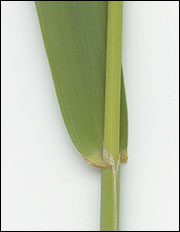Reed canarygrass (Phalaris arundinacea L.)
Cool-season grasses
Reed canarygrass is a tall, coarse, rhizomatous perennial grass. Its most distinctive characteristic is that it will survive on poorly drained soils or under flooded conditions better than any other cool-season grass. It is also drought-tolerant because of its deep and extensive root system. Reed canarygrass is nutritious in its vegetative state but becomes coarse and unpalatable as it matures. Old cultivars contain several alkaloids that can depress animal performance. However, many new cultivars have lower levels of these compounds. Many producers find reed canarygrass difficult to establish because the seeds often germinate slowly and irregularly. However, once established, it will out-compete other grasses in a mixed pasture. It can be quite useful if grazing begins early in the season and it is kept in its vegetative form.
 Reed canarygrass
Reed canarygrass
 Yield distribution of annual Kentucky in Missouri.
Yield distribution of annual Kentucky in Missouri.
- Origin: Worldwide
- Adaptation to Missouri: Statewide
- Growth habit: Rhizomatous, sod-forming, perennial.
- Blade: Rolled in bud, flat, sharp pointed, midrib prominent on lower surface, margins scabrous.
- Sheath: Split, smooth, glabrous, pale pink, round, with membranous edges.
- Ligule: White, membranous, pubescent on back, about ¼ inch long, margin smooth or serrate, usually split. Auricles: Absent.
- Seed head: Mostly compact panicle.
- Fertilization: 40 to 60 lb N/acre after the first grazing or harvest in spring, followed by another 40 lb N/acre after the second grazing if growing conditions permit. Phosphorus and potassium to soil test.
- Timing of production: 50 percent of growth before June 15.
- When to begin grazing: When grass is 6 to 8 inches tall.
- When to cut for hay: Just prior to heading.
- Lowest cutting or grazing height: 3 to 4 inches
- Fall management: Light grazing possible in September and October. Leave a 6-inch stubble for winter.

